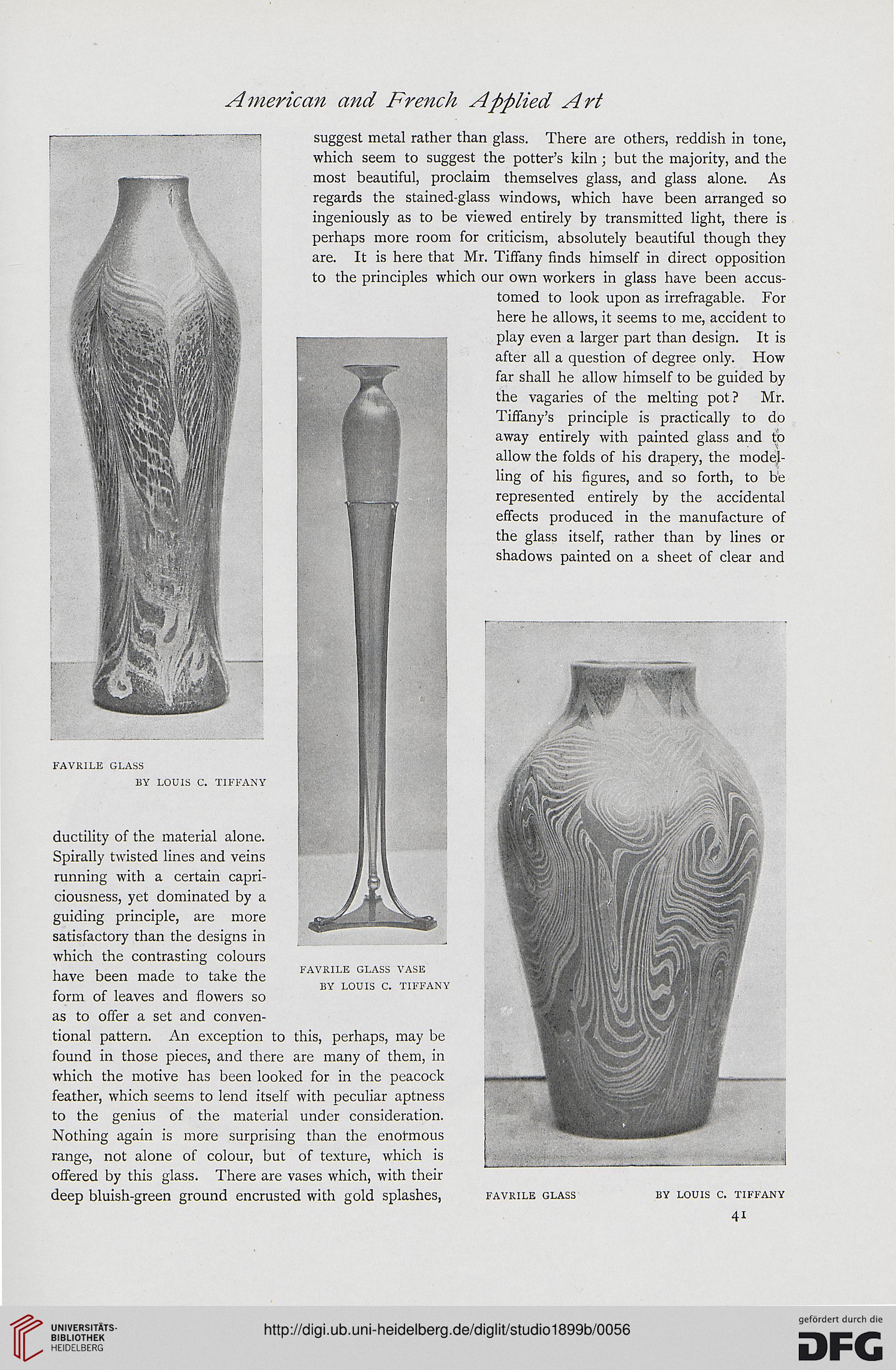American and French Applied Art
suggest metal rather than glass. There are others, reddish in tone,
which seem to suggest the potter’s kiln ; but the majority, and the
most beautiful, proclaim themselves glass, and glass alone. As
regards the stained-glass windows, which have been arranged so
ingeniously as to be viewed entirely by transmitted light, there is
perhaps more room for criticism, absolutely beautiful though they
are. It is here that Mr. Tiffany finds himself in direct opposition
to the principles which our own workers in glass have been accus-
tomed to look upon as irrefragable. For
here he allows, it seems to me, accident to
play even a larger part than design. It is
after all a question of degree only. How
far shall he allow himself to be guided by
the vagaries of the melting pot? Mr.
Tiffany’s principle is practically to do
away entirely with painted glass and to
allow the folds of his drapery, the model-
ling of his figures, and so forth, to he
represented entirely by the accidental
effects produced in the manufacture of
the glass itself, rather than by lines or
shadows painted on a sheet of clear and
FAVRILE GLASS BY LOUIS C. TIFFANY
41
FAVRILE GLASS
BY LOUIS C. TIFFANY
FAVRILE GLASS VASE
BY LOUIS C. TIFFANY
ductility of the material alone.
Spirally twisted lines and veins
running with a certain capri-
ciousness, yet dominated by a
guiding principle, are more
satisfactory than the designs in
which the contrasting colours
have been made to take the
form of leaves and flowers so
as to offer a set and conven-
tional pattern. An exception to this, perhaps, may be
found in those pieces, and there are many of them, in
which the motive has been looked for in the peacock
feather, which seems to lend itself with peculiar aptness
to the genius of the material under consideration.
Nothing again is more surprising than the enotmous
range, not alone of colour, but of texture, which is
offered by this glass. There are vases which, with their
deep bluish-green ground encrusted with gold splashes,
suggest metal rather than glass. There are others, reddish in tone,
which seem to suggest the potter’s kiln ; but the majority, and the
most beautiful, proclaim themselves glass, and glass alone. As
regards the stained-glass windows, which have been arranged so
ingeniously as to be viewed entirely by transmitted light, there is
perhaps more room for criticism, absolutely beautiful though they
are. It is here that Mr. Tiffany finds himself in direct opposition
to the principles which our own workers in glass have been accus-
tomed to look upon as irrefragable. For
here he allows, it seems to me, accident to
play even a larger part than design. It is
after all a question of degree only. How
far shall he allow himself to be guided by
the vagaries of the melting pot? Mr.
Tiffany’s principle is practically to do
away entirely with painted glass and to
allow the folds of his drapery, the model-
ling of his figures, and so forth, to he
represented entirely by the accidental
effects produced in the manufacture of
the glass itself, rather than by lines or
shadows painted on a sheet of clear and
FAVRILE GLASS BY LOUIS C. TIFFANY
41
FAVRILE GLASS
BY LOUIS C. TIFFANY
FAVRILE GLASS VASE
BY LOUIS C. TIFFANY
ductility of the material alone.
Spirally twisted lines and veins
running with a certain capri-
ciousness, yet dominated by a
guiding principle, are more
satisfactory than the designs in
which the contrasting colours
have been made to take the
form of leaves and flowers so
as to offer a set and conven-
tional pattern. An exception to this, perhaps, may be
found in those pieces, and there are many of them, in
which the motive has been looked for in the peacock
feather, which seems to lend itself with peculiar aptness
to the genius of the material under consideration.
Nothing again is more surprising than the enotmous
range, not alone of colour, but of texture, which is
offered by this glass. There are vases which, with their
deep bluish-green ground encrusted with gold splashes,




